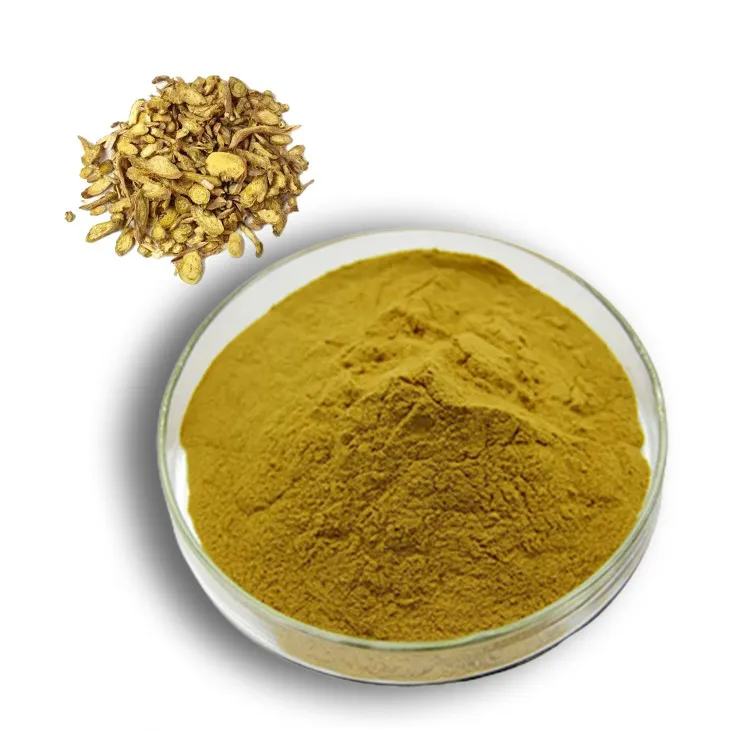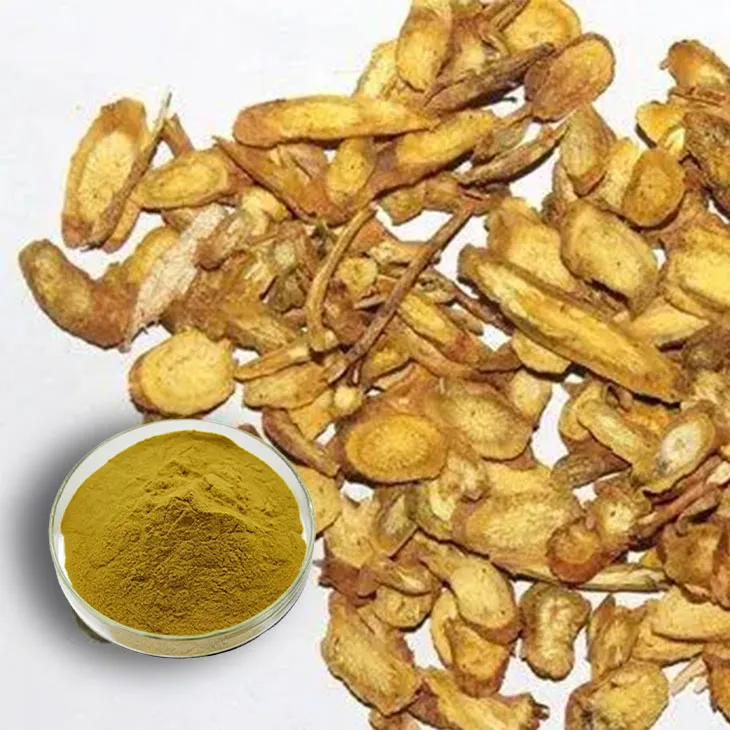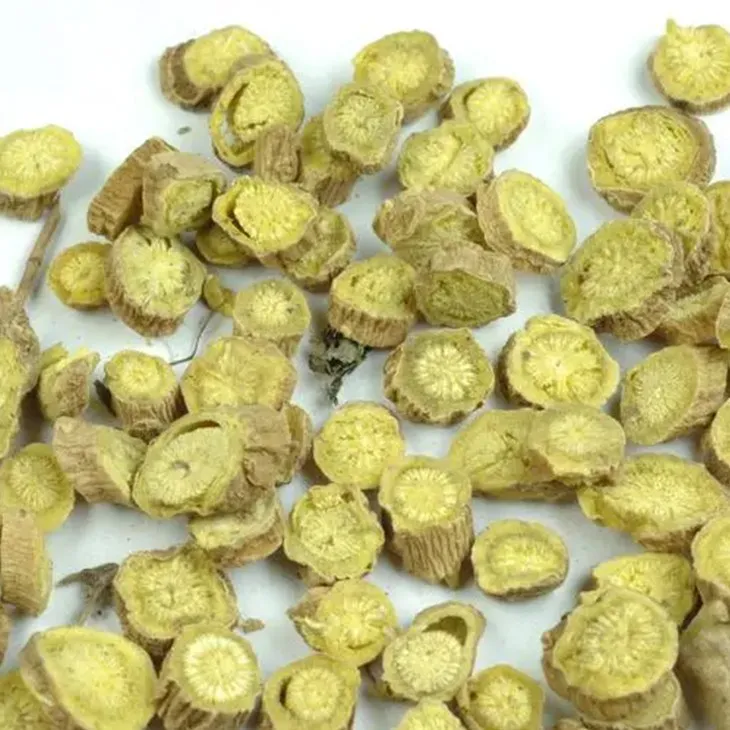- 0086-571-85302990
- sales@greenskybio.com
The process of extracting baicalin flavonoid glycosides from Scutellaria baicalensis extract.
2024-11-26

1. Introduction
Scutellaria baicalensis, also known as Chinese skullcap, has been used in traditional Chinese medicine for centuries. It contains various bioactive compounds, among which Baicalin flavonoid glycosides are of particular interest. Baicalin has shown a wide range of pharmacological properties, such as anti - inflammatory, antioxidant, antibacterial, and antiviral activities. Therefore, the extraction of Baicalin from Scutellaria baicalensis extract is crucial for its application in the pharmaceutical and nutraceutical industries.

2. Traditional Extraction Methods
2.1. Decoction
Decoction is one of the most traditional methods for extracting active components from herbs. For Scutellaria baicalensis, the process typically involves the following steps:
- First, the dried Scutellaria baicalensis root is crushed into small pieces.
- Then, a certain amount of water is added to the crushed root. The ratio of the root to water is usually determined based on experience, for example, 1:10 (w/v).
- The mixture is heated and boiled for a certain period, usually about 1 - 2 hours.
- After boiling, the solution is filtered to remove the solid residues, and the filtrate contains the extracted components, including baicalin.
2.2. Maceration
Maceration is another traditional extraction method.
- The crushed Scutellaria baicalensis is placed in a container, and a suitable solvent (usually ethanol - water mixture) is added.
- The container is sealed and left at room temperature for a period of time, which can range from several days to weeks. During this time, the solvent gradually penetrates the plant material and extracts the active components.
- After the maceration period, the solution is filtered to obtain the extract containing baicalin.

3. Modern Extraction Methods
3.1. Ultrasonic - Assisted Extraction
Ultrasonic - assisted extraction has become a popular modern method for extracting baicalin.
- The Scutellaria baicalensis extract is placed in a suitable solvent, such as an ethanol - water solution.
- An ultrasonic device is then used to irradiate the solution. The ultrasonic waves create cavitation bubbles in the solvent. When these bubbles collapse, they generate intense local pressure and temperature changes, which can effectively break the cell walls of the plant material.
- This helps to release the baicalin trapped inside the cells more efficiently. The extraction time is usually much shorter compared to traditional methods, typically ranging from 15 minutes to 1 hour.
- After extraction, the solution is filtered to obtain the baicalin - containing extract.
3.2. Microwave - Assisted Extraction
Microwave - assisted extraction is also a modern and efficient method.
- The Scutellaria baicalensis material and the extraction solvent are placed in a microwave - transparent container.
- The microwave is then used to irradiate the mixture. Microwaves can cause rapid heating of the solvent and plant material due to the interaction between microwaves and polar molecules in the system.
- This rapid heating can lead to the rupture of cell walls and the release of baicalin. The extraction time is usually very short, often within 10 - 30 minutes.
- Finally, the extract is filtered to obtain the baicalin - rich solution.
3.3. Supercritical Fluid Extraction
Supercritical fluid extraction is a more advanced method.
- Carbon dioxide (CO₂) is often used as the supercritical fluid. At supercritical conditions (above its critical temperature and pressure), CO₂ has properties between a gas and a liquid, which makes it an excellent solvent for extracting baicalin.
- The Scutellaria baicalensis extract is placed in an extraction vessel along with the supercritical CO₂. The supercritical CO₂ can penetrate the plant material and selectively extract baicalin.
- By adjusting the pressure and temperature, the solubility of baicalin in the supercritical fluid can be controlled, allowing for efficient extraction.
- After extraction, the supercritical fluid is depressurized, and the baicalin is collected.

4. Optimization of Baicalin Extraction
4.1. Selection of Solvent
The choice of solvent is crucial for efficient baicalin extraction.
- Ethanol - water mixtures are commonly used solvents. The ratio of ethanol to water can significantly affect the extraction efficiency. For example, a higher ethanol concentration may increase the solubility of baicalin, but it may also extract more impurities. A balance needs to be found. Studies have shown that an ethanol - water ratio of around 70:30 (v/v) can often achieve good extraction results.
- Other solvents, such as methanol, have also been investigated. However, methanol is more toxic, so its use needs to be carefully considered, especially in the production of nutraceuticals.
4.2. Optimization of Extraction Parameters
- For ultrasonic - assisted extraction, the power of the ultrasonic device, extraction time, and solvent - to - sample ratio are important parameters. Increasing the ultrasonic power can enhance the extraction efficiency, but too high power may cause degradation of baicalin. The extraction time should be optimized to ensure maximum extraction while minimizing the degradation of the compound. A solvent - to - sample ratio of around 10:1 (v/w) is often used, but this can also be adjusted according to the specific situation.
- In microwave - assisted extraction, the microwave power, extraction time, and temperature are key factors. Appropriate microwave power and short extraction time can prevent over - heating and degradation of baicalin. The temperature should be carefully controlled to ensure the stability of the target compound.
- For supercritical fluid extraction, the pressure, temperature, and flow rate of the supercritical fluid are critical parameters. By optimizing these parameters, the selectivity and efficiency of baicalin extraction can be improved.
4.3. Pretreatment of Raw Materials
Pretreatment of Scutellaria baicalensis can also affect the extraction efficiency.
- Grinding the raw material to a proper particle size is important. Finer particles can increase the surface area exposed to the solvent, thus enhancing the extraction efficiency. However, if the particles are too fine, it may lead to problems such as clogging during extraction.
- Some pretreatment methods, such as drying, can also affect the extraction. Different drying methods (e.g., air drying, freeze - drying) may result in different physical and chemical properties of the raw material, which in turn can influence the extraction of baicalin.

5. Purification of Baicalin Extract
After extraction, the obtained extract usually contains impurities along with baicalin. Purification is necessary to obtain high - purity baicalin.
- One common purification method is column chromatography. In this method, the extract is passed through a column filled with a suitable adsorbent, such as silica gel or resin. Baicalin and impurities have different affinities for the adsorbent, so they can be separated as they pass through the column.
- Recrystallization is also used for purification. By dissolving the extract in a suitable solvent and then allowing it to recrystallize under controlled conditions, pure baicalin crystals can be obtained. However, this method requires careful selection of the solvent and control of crystallization conditions.
6. Conclusion
The extraction of baicalin flavonoid glycosides from Scutellaria baicalensis extract is a complex process. Traditional methods such as decoction and maceration have been used for a long time, but modern methods like ultrasonic - assisted extraction, microwave - assisted extraction, and supercritical fluid extraction offer higher efficiency and better control. Optimization of extraction parameters, solvent selection, and raw material pretreatment can significantly improve the extraction efficiency and purity of baicalin. Purification methods are also essential to obtain high - quality baicalin for its applications in the pharmaceutical and nutraceutical industries. With the continuous development of technology, more efficient and environmentally - friendly extraction and purification methods are expected to be developed in the future.
FAQ:
What are the main traditional methods for extracting baicalin from Scutellaria baicalensis extract?
Traditional methods for extracting baicalin mainly include solvent extraction. For example, using ethanol - water mixtures as solvents. This method takes advantage of the solubility of baicalin in certain solvents. The plant material is soaked in the solvent for a period of time, and then through filtration, concentration and other steps to obtain the extract containing baicalin.
What modern techniques can be used for the extraction of baicalin?
Modern techniques such as ultrasonic - assisted extraction and supercritical fluid extraction can be used. Ultrasonic - assisted extraction can enhance the mass transfer process by using ultrasonic waves, which shortens the extraction time and improves the extraction efficiency. Supercritical fluid extraction, often using carbon dioxide as a supercritical fluid, has the advantages of high selectivity, no solvent residue, and can obtain high - purity baicalin.
How can the purity of baicalin extracted from Scutellaria baicalensis extract be improved?
To improve the purity of baicalin, multiple purification steps can be carried out. After the initial extraction, techniques like column chromatography can be used. Different adsorbents in the column can selectively adsorb impurities, allowing baicalin to be purified. Recrystallization is also a common method, which can further remove remaining impurities by dissolving the crude extract in a suitable solvent and then allowing it to recrystallize.
Why is the extraction of baicalin important in the pharmaceutical and nutraceutical industries?
Baicalin has important pharmacological properties. In the pharmaceutical industry, it may have anti - inflammatory, antibacterial, antiviral and antioxidant effects. In the nutraceutical industry, due to its potential health - promoting properties, it can be used in the development of dietary supplements. Therefore, proper extraction to ensure high - quality baicalin is crucial for these industries.
What factors need to be considered when optimizing the extraction of baicalin?
When optimizing the extraction of baicalin, factors such as the type and concentration of the solvent, extraction time, extraction temperature, and the ratio of raw materials to the solvent need to be considered. For example, different solvents may have different solubilities for baicalin, and the extraction efficiency may change with different extraction times and temperatures. Adjusting these factors appropriately can improve the extraction yield and quality of baicalin.
Related literature
- Optimization of Baicalin Extraction from Scutellaria baicalensis Georgi by Response Surface Methodology"
- "Comparative Study on Different Extraction Methods of Baicalin from Scutellaria baicalensis"
- "Efficient Extraction and Purification of Baicalin from Scutellaria baicalensis for Pharmaceutical Applications"
- ▶ Hesperidin
- ▶ citrus bioflavonoids
- ▶ plant extract
- ▶ lycopene
- ▶ Diosmin
- ▶ Grape seed extract
- ▶ Sea buckthorn Juice Powder
- ▶ Beetroot powder
- ▶ Hops Extract
- ▶ Artichoke Extract
- ▶ Reishi mushroom extract
- ▶ Astaxanthin
- ▶ Green Tea Extract
- ▶ Curcumin Extract
- ▶ Horse Chestnut Extract
- ▶ Other Problems
- ▶ Boswellia Serrata Extract
- ▶ Resveratrol Extract
- ▶ Marigold Extract
- ▶ Grape Leaf Extract
- ▶ blog3
- ▶ Aminolevulinic acid
- ▶ Cranberry Extract
- ▶ Red Yeast Rice
- ▶ Red Wine Extract
-
Citrus Aurantii Extract
2024-11-26
-
Bamboo Leaf extract
2024-11-26
-
Dandelion Leaf Extract
2024-11-26
-
Lotus leaf extract
2024-11-26
-
Tormentil Extract
2024-11-26
-
Dan Shen Root Extract/Salvia Root Extract
2024-11-26
-
Sugarcane Extract
2024-11-26
-
Aguaje Extract
2024-11-26
-
Camu Camu Extract
2024-11-26
-
Lemon Extract
2024-11-26





















